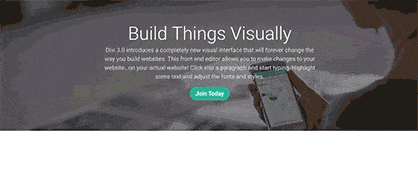How to Get Clients as a Freelance Developer: The Complete Guide

One of the hardest things for a freelance developer is getting clients.
- What do you say?
- Where do you start?
- How much should you charge?
In this article, we’re going to talk about the strategies you can use to get clients and how the pros do it while working fewer hours.
But first, let’s first talk about the word “client”.
So many freelancers focus on “getting clients”, but the focus should instead be on getting the “right clients”.
As cheesy as that may sound, this can make all the difference.
Who are the “right clients”?
- Clients who you are passionate about helping.
- Clients who see value in your services and pay you accordingly.
Nobody wants to work with a client who doesn’t pay, has a lot of demands, and treats you like they own you. And yet, this is exactly the type of clients many freelance developers attract.
So, how do you change this?
Marketing
To get the right clients, you have to market yourself the right way.
We answer all of that and more in this massive 5,727 word detailed guide, so if you don't have a coffee, grab one now.
Overview
- Things You Need to Have Before Marketing
- Getting Your First Client
- Getting More Clients
Let’s get started 🔥
Things You Must Have
Before you market yourself, you need to have something valuable to market.
It may seem obvious, but a lot of web developers go ahead without first deciding what kind of business they want to build.
You first have to come up with the following:
- Brand Identity
- Niche vs Generalizing
- Portfolio Website
- Pricing structure
Prefer watching?
1: Brand Identity (Building Your Personal Brand)
Your personal brand is how you want people to think and feel about you as a freelance developer. It represents who you are, your core values, and what sets you apart from other developers.
In a saturated market, your personal brand is the key to stand out.
Branding is all about perception. It's up to you how to shape and influence that perception and this will help you land clients.
Here are some things to think about to build a unified brand image:
Who is your ideal client?
You have two choices here: target general clients or target a specific niche (more on this later).
You also have to consider their challenges, goals, and how you can provide solutions for helping them.
You can use HubSpot’s persona tool to quickly come up with a client persona as well.
What is your unique selling proposition?
Your USP tells clients what you offer, why they should choose you, and what sets you apart from the competition.
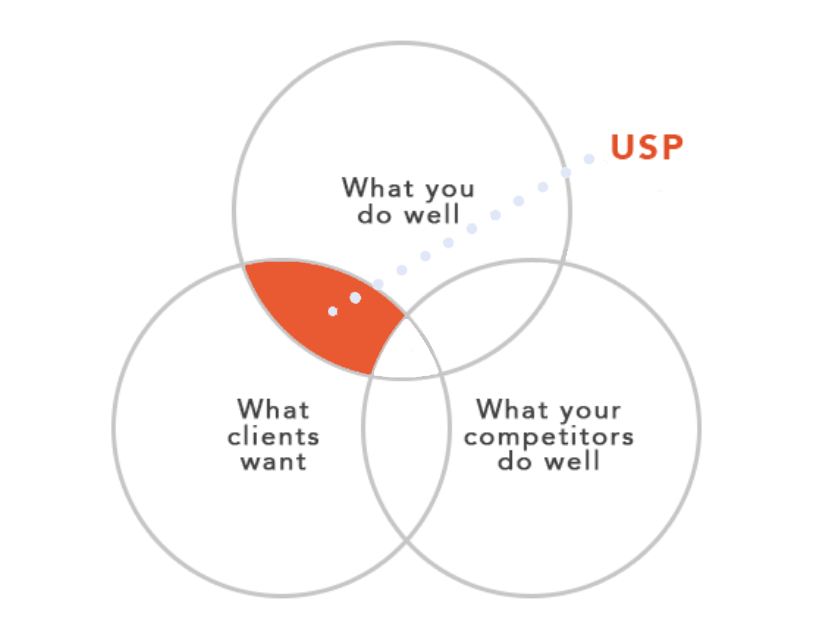
Good examples of a USP:
“I create stylish e-commerce websites for fashion brands.”
“I create affordable 1-page websites for small businesses in 1 day.”
“I help dentists get more patients - guaranteed.”
These USP's state who your ideal clients are, what you can do for them, and what sets you apart from the others.
Your USP can also include a unique bundle of services (e.g. web development + marketing) or even your personal story that people would love to spread around.
2: Choose a Niche (to Niche or not to Niche?)
In contrast to targeting everyone who needs a website, niching down means you’ll create websites for a specific niche like health and fitness, coffee shops, online courses, etc.
Although you don’t need to niche down to be a successful freelancer (there are lots of successful generalists), targeting a niche will allow you to charge higher, quickly establish yourself as an expert, and have clients lined up to work with you.
Here are 5 good examples of niching down:
Churches:
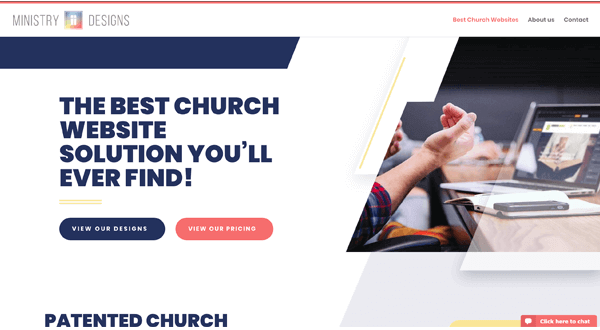
Restaurants:
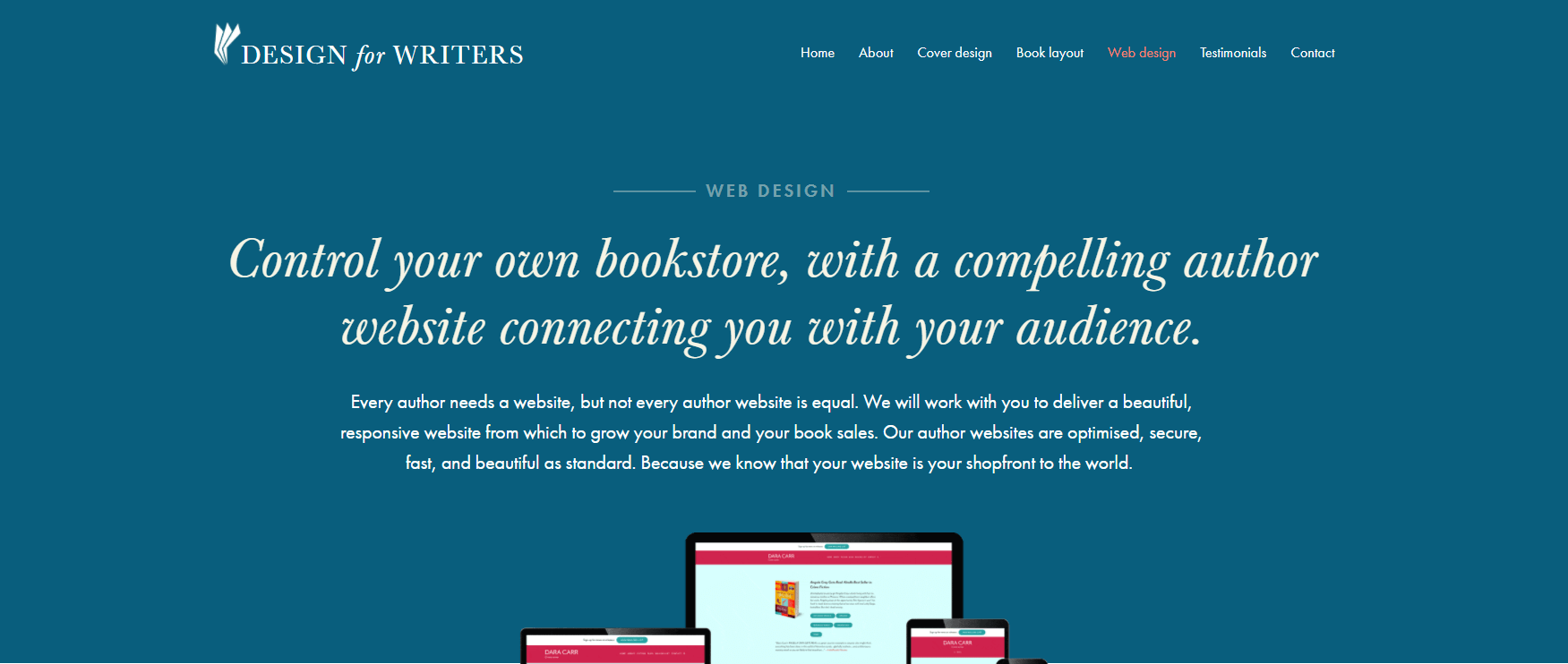
E-commerce:
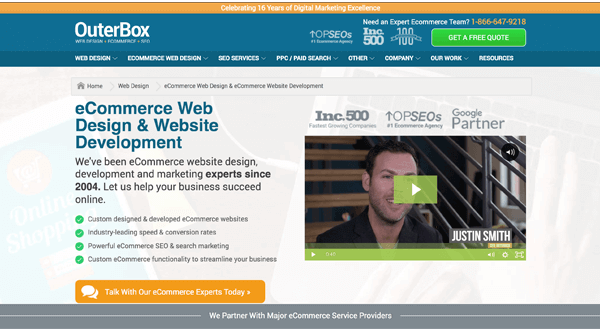
Legal:
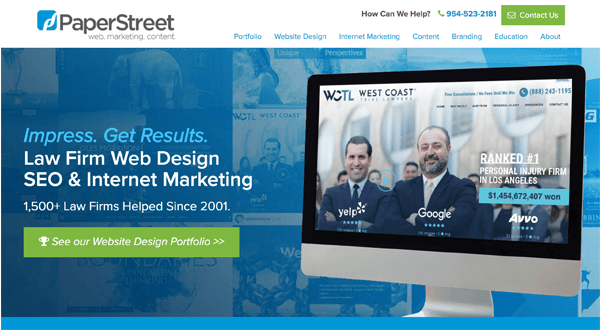
Medical:
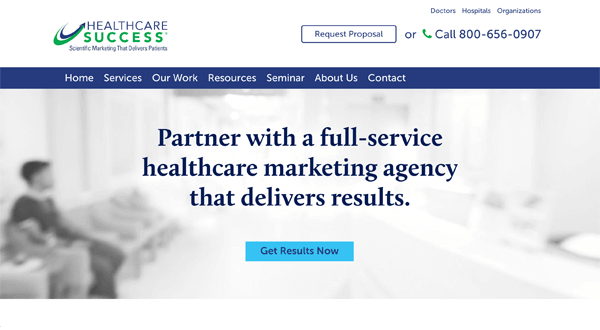
These are some considerations if you decide to niche down:
- It’s best to choose a niche that you are interested in or have some prior knowledge of
Do you go fishing on weekends? Do you hike, knit, paint or work out in your spare time? Think of your hobbies or industries you have a background in and start from there. It’s easier to create a website about something you know about and enjoy. - Your niche influences your pricing
A website for a law firm can cost over $5,000, but this will be too high for a local bakery shop. - You don’t have to stay in one niche forever
Many freelance developers freak out at the thought of working in the same niche for years, but that shouldn’t be the case. You can explore other niches once you gain traction in your first niche or once you feel that the niche isn’t really for you. Here's an agency that does this well (law and pest control).
We personally have 3 niches and it works well for us, so we'd recommend it for you.
3: You Need a Portfolio
Once you have a clear brand image and you’ve decided whether to generalize or niche down, it’s time to design a portfolio site.
We discuss it in detail in Freelancing and Beyond, but a portfolio is more than an online CV or resume where you list all your credentials and educational background.
Here's the golden rule:
A client cares about if you can help solve their problems.
Pretend that you’re a coffee shop owner and you want to have a website. Which of the two portfolios will appeal more to you?
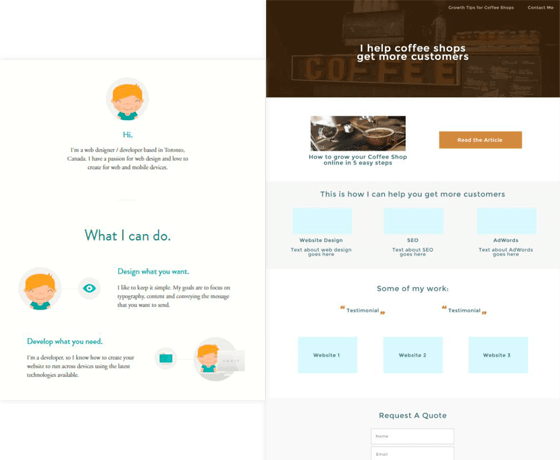
If your answer is not the portfolio on the right, I’d be surprised.
Although the first portfolio looks amazing, has clear copy and looks professional, the second portfolio is tailor-made for coffee shops.
This, in the eyes of a coffee shop owner, is 100x more appealing.
But what if you're a beginner and you haven’t built a single website?
Much like the classic chicken and egg scenario (the chicken came first), you need a portfolio to get a client, but how will you have a portfolio without a client?
You have 2 options:
- Create 2 websites for free in exchange for a testimonial.
- Buy 2 domains and create the websites yourself.
Create 2 websites for free – You may not like it, but this is the easiest way to gain experience. This involves three steps:
Step 1: Find someone who needs a website. It can be a local small business owner or someone you know. Look for their email address on local website directories, local magazines or yellow pages. You can also get their email address on their existing website if you feel that you can improve on it.
Step 2: Send them this email:
Hi [name],
I recently came across your [niche] business and I noticed you don't have a website.
I am a web designer and I would love to create your website for FREE (no catches or hidden fees) in exchange for a testimonial from you that I can use on my website.
I'm looking to get a few testimonials as it will help me in the future.
Would you be willing to take me up on this offer?
If you have any questions, please feel free to contact me.
Regards,
Your Name
Your Contact Number
If they don’t reply, give them a call and be sure to follow up after a few days.
Step 3: Create the website. You can use Themeforest.net to buy themes (often for under $20).
Another option is to use Divi which allows you to create WordPress websites with ease. We use it for every WP website.
Buy 2 domains and create the websites yourself – this often surprises people, but it makes a lot of sense.
If clients only want to see that you can create a professional website for them, then why can’t you just create sample websites yourself?
This option won’t get you testimonials, but it’s a quick way to get started.
Just buy two domains that are related to the client’s niche and build the websites. It’s a clever way to build a portfolio and to showcase your expertise.
4: You Need a Pricing Strategy
We have a massive guide and video on how to price your services as a developer (video below):
Here are the nuggets:
- A website is not just a website
It’s a marketing tool that will bring businesses more sales. Shouldn’t they be willing to pay more for a tool that earns them more money? - Your pricing depends on your niche
If you want to target law firms, charging $2,500 for a website may make them doubt your experience and credibility. But if you charge $2,500 for a coffee shop website, it may be too steep. - Clients don't always go for the cheapest option
This is a myth and will put you in a bad position down the road. Low pricing will put you right alongside millions of other developers that are often seen as commodities. How will you stand out? - Charging more (and delivering results) will help position you as an expert
No matter how saturated the market becomes, people will always be willing to pay a premium to experts.
🔥Takeaways🔥:

- Focus on the RIGHT Client
- Build a Personal Brand
- Have a USP
- Choose a Niche
- Build a Portfolio
- Have the RIGHT Pricing
Getting Your First Client as a Developer 🔥
With the foundation out of the way, let’s get to HOW you can find and get your first client.
The strategies that we discuss here have worked for us over the years (and still do now).
Besides telling your friends and family you can create websites for them, these are the some of best outreach strategies to try:
- Google Ads
- Facebook Groups
- LinkedIn Outreach
- Freelance Platforms
- Manual Outreach
1: Google Ads

Google AdWords is an effective tool to get your first client. It’s the ads that you see on top of the search results:
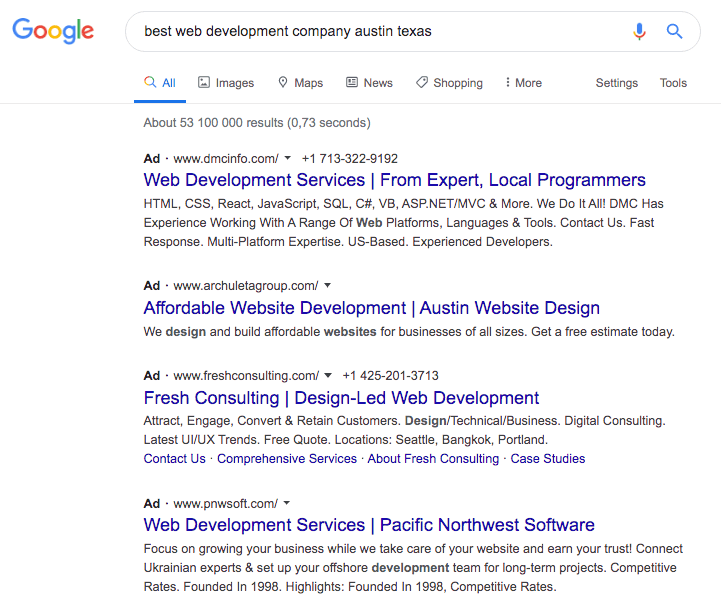
Every time the ad i clicked, you pay for it.
The average Cost-Per-Click is $1 - $3+ depending on the industry competitiveness.
If you’re selling a website for $500, would you be willing to spend $50 to close a deal with a client whom you can potentially upsell with marketing services?
Absolutely. What about $100? $200? $300?
You have to decide how much you’re willing to pay in relation to what you can potentially earn.
3 search terms you should consider to bid on are:
- "web design agency"
- "web design services"
- "freelance developer"
- "freelance web designer"
PRO TIP:
Make sure to add a few Negative Keywords like:
- "courses"
- "ideas"
- "inspiration"
- "jobs"
- "learn"
And remember to target your desired locations only.
To succeed in Google AdWords, you need to have a great ad copy, target the right audience, have a high converting landing page template, structure the campaign properly, and more.
The learning curve is steep, especially to learn it well, but it’s worth your time. I like it a lot because it not only helps you get clients, but you can also offer it as a service to your clients, so you get a monthly retainer income.
My top recommendation is this course on Udemy and if you prefer to read, this is a good resource.
2: Facebook Groups

Not a lot of people realize how powerful Facebook groups can be as marketing tools. And that’s partly what makes it so appealing.
There are two ways to use Facebook groups to sell your services:
- Join existing Facebook groups of your target clients.
- Create your own Facebook group and add your target clients as members.
1 - Join Existing Facebook Groups
The idea here is joining a Facebook group where your target clients are members of and adding value by commenting, answering questions related to websites or your other services, giving suggestions, etc.
For example, if your target client is business coaches, you can search for groups related to this niche:
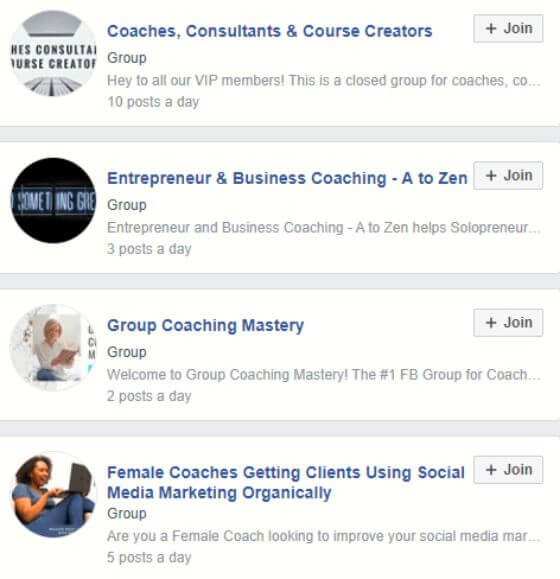
Join three groups, introduce yourself, and start adding value by engaging with them.
If you do this consistently for a few months, they will recognize you as someone who is helpful and can add value to their community.
Avoid directly selling your services the first time or every single time you engage because it will come off as spammy.
You have to give value first before they trust you enough to want to know more about your services.
Once you become a trusted member, then you can introduce your services to them. Sometimes you won’t even have to initiate it because as you help people out, they will begin to trust you, become curious, and ask you for help.
It sounds so simple, but it works and you'll get a good amount of client leads.
2 - Create Your Own Facebook Group
If there are no existing Facebook groups with your specific target clients as members or if your niche is too specific (e.g. limited to an area or a hyper-specialized niche), then create your own Facebook group and add them as members.
Creating your own Facebook group helps you build lasting relationships with targeted clients and positions you as an expert in the industry.
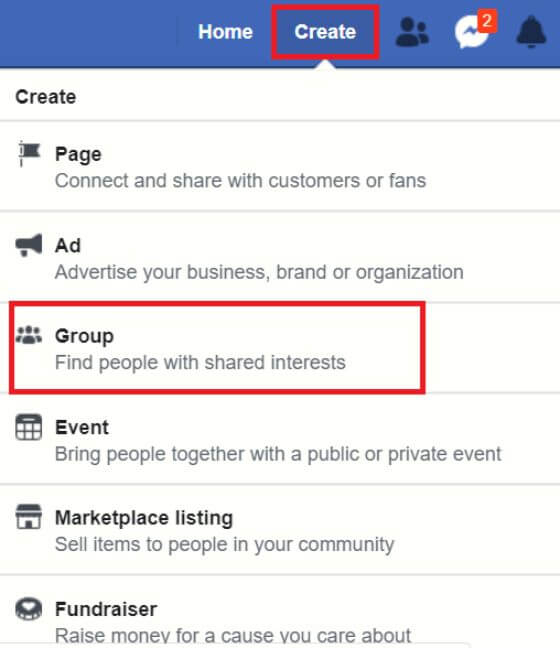
For example, if you’re targeting business coaches in the “XYZ” city, add them to the group and begin adding value.
Write a post about clever marketing tips for business coaches or the top mistakes in websites of business coaches.
Here are some tips for your group:
- Interact with your members
Don’t just comment or post when you need something from them. It’s a community, and people want to build relationships, - Keep things interesting
Maybe you can come up with a simple contest where they can win exciting prices like a free landing page template. It can also be a chance to promote your services. - Establish group rules
For example, forbid foul language or hateful speech. - Build a relationship
Once you have a relationship with them, you can send a message or post occasionally to the group about how your services can help grow their business. - Be yourself
People can tell if someone’s not being genuine. Share your stories and let your personality show.
Don’t be overwhelmed with the thought of creating and maintaining your own Facebook group. You don’t need 1,000 members here. A hundred is great. As long as it’s targeted, you’ll get results.
It may take months to get paying clients, but it will get better and more effective the longer you do it. Just focus on converting 2-3% of the members to paying clients and focus on consistently growing the group.
3: LinkedIn Outreach

If you know who your ideal client is, LinkedIn has a lot of potential for you to get clients.
One of the most effective ways to get the most out of it is to use their ads.
Their targeting is accurate and it's where you get access directly to professionals, so if you can create an ad that gets their attention, you're on to a winner.
We use LinkedIn to get leads and the results have been very good.
Here is an overview of our suggestions:
- Use LinkedIn Post Ads
- Run the ads over a weekend
- Try a lead-form ad and a landing-page ad
- Create a funny ad, question ad and informative ad
- Run it for a month, then use the best performing ad
Another often neglected strategy is to connect with 20-30 profiles of your ideal client every day.
Before you know it, you'll have 500+ connections and you can add value in your posts, then eventually reach out to them to offer your services.
4: Freelance Platforms

Without listing 100+ job platforms to find work or earn a side income through freelancing, I'll discuss a brief example of what I did.
I used Fiverr.
I only worked with 3 clients and it resulted in 5 figures within 5 months.
To those who don't know what Fiverr is, it's a platform to sell services starting from $5.
This is my honest perspective of Fiverr:
Depending on the service you offer, it will be a waste of your time if you don't know how to take advantage of the benefits.
So, this is how the Fiverr side worked:
I looked at others who offered the same services as me (web design, digital marketing) and figured out how I could stand out as a complete newbie.
I noticed that their main image did not look good and if they had a video, it wasn't good. So, I decided to invest in making a good video which would help me stand out.
Then I found someone on Fiverr to design a decent animation video for around $80.
Because Fiverr is all about reviews, I needed to get legitimate reviews ASAP to help boost my credibility, so I asked my brother and my mom to order from me and write a review for me.
This may seem fishy, but I have done work for them in the past, so it's legit.
How I did it:
I charged $5 for a website conversion report (I gave advice on how to improve their website).
I got three purchases in total since I created my account around June 2016. Out of the three orders, one signed up for more projects after the initial conversion report (which I'll talk about now), another gave me a tip, and the last one was a cucumber (which I'll ignore for this article).
What's interesting is that my share of a $5 order is only $4 after Fiverr's fee which is basically a decent coffee.
If you think like most people, you would think wow… all that work for $4? Who would do that?
Me…
Most people price their services as once-off, but I knew I could be different in this by offering higher pricing tiers for more work.
My $5 report was valuable. I really aimed to over-deliver and spent hours on it. It was a brief 3-page overview on my suggestions to improve the overall website sales.
The next report was a $100 highly detailed action plan and UI document with a proposal of 4 figures for me to implement the action plan.
This resulted in an awesome client.
2 months later: his sales more than quadrupled.
3 months after that: 5 more websites ordered + we've been on a monthly recurring retainer for over 4 years now.
It's not easy to stand out on such a crowded marketplace when you are starting out – especially when you offer a commodity service like web development, but if you think innovatively about getting clients, you can make it work.
5: Manual Outreach

This strategy involves more work than the others, but there’s no getting around it.
If you were expecting it to be easy, you're reading the wrong article.
 “I always choose a lazy person to do a hard job. Because a lazy person will find an easy way to do it.”
“I always choose a lazy person to do a hard job. Because a lazy person will find an easy way to do it.”
Bill Gates
To be honest, I'm quite lazy. I'm so lazy in fact, that I didn't send my resume through to Bill, so I'm techinically his ideal employee.
🧀🧀🧀🧀🧀🧀🧀🧀🧀🧀🧀🧀🧀
Here's the simple truth:
If it were easy, everyone would be doing it.
It's not - so if you put in the work, you're one step ahead.
With that said, let's get into the actionable nuggets 🍗
Look for businesses in your niche here:
- Yellow pages
- Google/Google maps
- Local online business directories
- Facebook (search your niche keywords)
- Local print media like newspapers and flyers
Example:
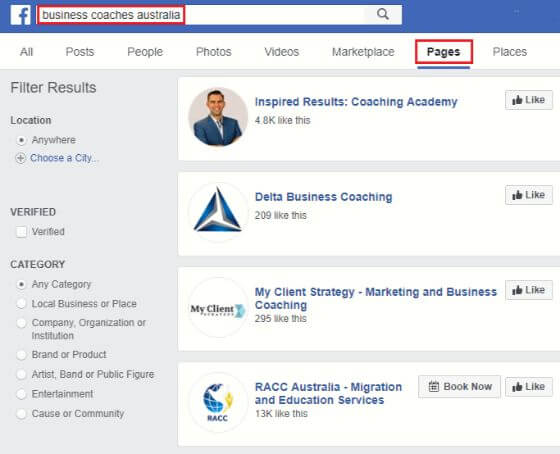
You are trying to find out the following:
- Do they have a website? If yes, how can you improve it? If not, proceed to the next step.
- Do they show up on Google for their business?
If you answer no to both questions, that means they can benefit from your services. Now it’s time for you to sell it to them.
Be mindful that you have to brace yourself for rejection, but you need to keep going. Listen to our podcast (episode 011) on Overcoming the Challenges of Getting Clients.
Remember the nugget rule:
It's a numbers game. The more you reach out to, the more chance you have of succeeding.
You can't contact 7 businesses and say it doesn't work. Give me a break (or a Kit-Kat 🍫).
Scenario: Business Has a Website
If they already have a website, send this email:
Hi [name or company name],
My name is [insert name], I recently came across your website after searching for [the search term you used].
I noticed that your website doesn’t display the important aspects that a [insert niche] website should display, such as:
- Clear contact details
- Clear company history
- Professional images and content
- Social media profiles
- Clear location and trading hours’ information
- Testimonials from students
Making these changes will help your [insert niche] appear to be more professional and you will gain more trust with potential customers.
I’d love to set up a call to discuss how I can help you get more customers through effective web design changes.
If you have any questions, feel free to contact me.
For more information about my expertise, here is my website: [www.mywebsite.com]
Thank you and I look forward to hearing from you.
Regards,
[Your name]
Scenario: Business Does Not Have a Website
If they don’t have a website yet, you can send them this email:
Subject Line: [Business Niche Company Name] Website
Hi [name or company name],
My name is [insert name] and I am a web designer based in [insert city].
I came across your [insert niche] business in the [insert media] and noticed you don’t have a website yet.
I’ve got experience in working with [insert niche] businesses to help them create effective websites on an affordable budget.
Would you be interested in discussing this further?
We can set up a call or I’d be happy to discuss this via email.
For more information about my expertise, here is my website: [www.mywebsite.com]
Thank you and I look forward hearing from you.
Regards,
[Your name]
If you don’t receive a reply after 3 days, send them this email:
(Make sure to forward the previous email, but change the ‘FW’ to ‘RE’ in the subject line).
Subject Line: RE: [Business Niche Company Name] Website
Hi [name or company name],
I’d just like to confirm if you received my email I sent a few days ago?
Regards,
[Your name]
If you don’t get a reply 2 days after your follow up, phone them.
To stay organized, compile every business you’ve researched and all relevant info about them in an excel file like this:

Keep doing these steps until you get the sale.
Getting a Steady Stream of Clients
After getting your first client, make sure to celebrate with some steak and wine because you just got your first win :)
I remember when I got my first real paying client for less than $50 and my wife and I were struggling financially at the time, but we still celebrated (by sharing a $5 meal) - it's an amazing moment.
Your next goal should naturally be to get your second client, third client, and fourth... As you work with more clients, you’ll become more confident in selling your services, creating websites that produce good results and running the whole business.
Now you don’t want to only rely on the tactics we’ve talked about earlier because they take too much time, finance and effort.
What you want is a steady stream of clients lining up to work with you. This often takes months (and even a few years for some industries), but your efforts will eventually pay off.
Here are a few ways you can get higher paying web design clients:
- Set Up a Sales Funnel
- Dominate Your Niche
- Be Top of Mind
- Get Your Clients Results
1: Set Up a Sales Funnel

If you’ve ever visited a website by clicking on a social media post or ad, you’ve entered a sales funnel.
A sales funnel is what million-dollar businesses use to get a steady flow of qualified leads that can potentially become paying clients.
We won't go into which sales funnel is the best, but we’ll discuss what works for us:
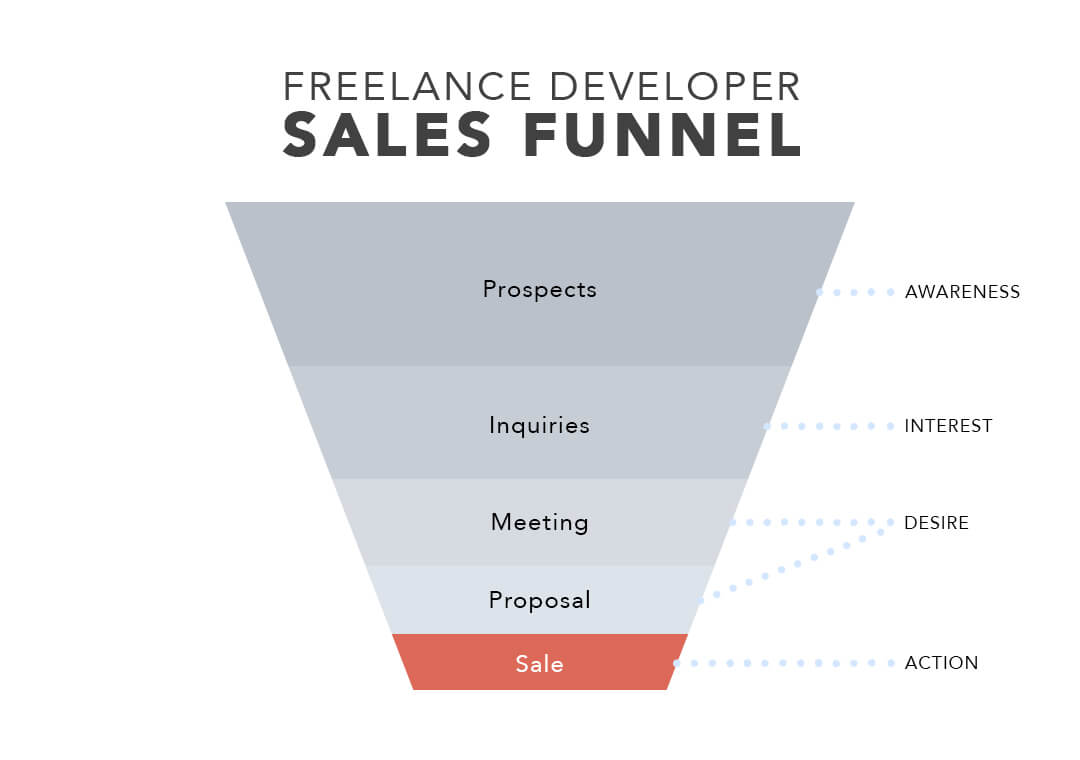
Depending on your niche, experience, pricing and how the client found your services, you should get between a 2% - 30% conversion rate from a Prospect to a Sale.
Example:
- A Prospect from AdWords or Email Outreach will convert to a Sale less than 5% of the time.
- A Prospect recommended from an existing client should convert to a sale more than 30% of the time.
One of the best ways to generate leads in the long-term is through Content Marketing.
This involves attracting website visitors using high-value content like blogs, videos, podcasts, e-books, whitepapers, and more. Some contents are given for free, some are given in exchange for an email (called a low-risk offer) which you can contact and let them know more about your services.
Some things to point out:
- In the first stage of the funnel called “Prospects” these people are just looking for information to solve their problems
A business consultant who’s not sure if a website is really that important might search for “benefits of having a website for business coaches.” If you have a blog about this topic that shows up on Google, they will read it and decide if it offers enough value to be worth their time. - People at this stage are also called “Cold Leads”
They are not ready to buy because they don’t have any idea who you are, so don’t sell them anything just yet. They don’t trust you enough to buy from you. - Make sure the content offers real value
People can tell if something is full of fluff and offers no real value. Only publish content that is well-researched, thorough, well-formatted and will leave your desired client thinking “Wow, that was helpful!” - If the content requires no registration, think of a way to get their email address
For example, you shouldn’t require people to register before reading a blog. What you can do is use pop-up forms, offer a free email course or something valuable.
Other incentives for email sign-ups:
- A free eBook
- A free download/checklist
- A free 30-minute consulting call
- Stay up to date on the latest articles published
Once you get their email addresses, you can send them regular high-value content that will show them who you are, what you do, and how you can help solve their pain points. You can start selling your services in your third or fourth email.
The best part is you can automate these emails using tools like Mailerlite so it becomes a self-running machine that works 24/7 to bring you leads.
The second stage is where people begin to like you and start getting curious about you. They visit your social media sites, read your testimonials and about us page, attend your webinars, and find out more about what you offer.
This is also where will compare your services to other web developers, so it’s important to reinforce your USP.
If they decide that your services are a perfect fit for their needs, that’s when they will inquire and finally buy. Only a small percentage of your leads will get to this point.
That’s why it’s important to get as many (targeted) website visitors as possible.
If you get 500 visitors a month at only a 1% conversion rate into paying customers, that’s 5 paying clients.
Many studies show that organic search remains the top source of web traffic, which proves why SEO needs to be a priority.
Paid search, social media posts, and other sources like social media posts, emails, referrals, and links from other websites are also great sources of traffic - the only "negative" is that it costs money.
If you're a newbie to this, here’s a detailed article on 27 ways to increase your web traffic.
🔥Takeaways:🔥
- A sales funnel is a powerful tool that when used right can bring you a steady flow of clients.
- There are so many ways to create your own funnel. You can have more than one funnel. Find the flow/strategy that’s most effective for your business.
- Look for ways to automate parts of your sales funnel to save time and get better results.
- SEO should be a part of your long-term marketing strategy.
2: Dominate Your Niche

If you want people to line up for your services, there’s no other way than to establish yourself as an expert.
There are so many ways to do this, but it all boils down to building your online presence until people in your niche recognize your name. Until you become the “website guy” for business coaches, coffee shops, accountants, law firms; whatever your niche is.
You don’t have to code for 10,000 hours before you can start positioning yourself as an expert.
While it’s important to master your skill, when can you really tell if you’re an “expert” at coding?
When you’ve mastered all the languages? What about the new technologies that pop up all the time. When will your practice to become an expert at coding end?
The point here is it’s all about Positioning.
Positioning is doing or saying strategic things that help others to perceive you as an expert. Of course, we're not saying you should be a con artist or a lier - you have to be truthful and back up your claims with amazing results!
How do you position yourself as an expert?
- Write an e-Book
Don’t be overwhelmed with the thought of writing a book. Becoming an authority is one of the best ways to boost your credibility. If you’re not confident that you can write in a way that people won’t be wanting to “throw” the book away, you can hire a freelance ghostwriter to write it for you. - Go on interviews
Get yourself interviewed on podcasts or articles related to your niche industry. Talk about your story, how you became a niched web developer and tips on how they can grow their business. - Guest post
Write articles for other websites in your industry (even better if it’s as high profile as Forbes or Entrepreneur) and link back to your website. - Share case studies
By now, you would have worked with clients and your websites would have produced results. Showcase these results in case studies to show people that you walk the talk. Let your results do the talking. - Start a podcast
Through a podcast, you’ll have a chance to teach people about how they can grow their business, and teachers are seen as experts.
An e-Book example could be: How to Double Your Psychology Clients with Internet Marketing.
3: Be Top of Mind

Have you heard of The Rule of 7?
That is, people see your brand or services 7 times, and eventually they will buy.
The more people see your brand, the more likely they are to buy/sign up/become a client.
Besides for what we discussed above, the best way to do this is through Retargeting.
What is Retargeting?
If you've ever visited a website and then saw ads about that product or website again on a different website - that's retargeting.
How do you retarget your website visitors? You can use Google Ads and/or Facebook Ads
We won't go into the steps of setting it up as it's quite a process, but just make sure you're doing this (for your business and your clients' businesses).
Learn how to setup retargeting ads here.
4: Get Your Client Results

This is the most important step in getting more clients.
The best type of clients are:
- Clients who stay with you
- Clients who refer others to you
The only way clients will stay with you and recommend you to others is if you get them results.
This means you should spend your time learning and reading case studies on what works and how you can become better as a developer and freelancer.
When creating a website, use the right colors, lay out the website focused on a CTA, align your marketing efforts to drive more sales and offer an exceptional service to your clients.
Doing the work to just tick it off is not good enough. Know WHY you are doing what you're doing for the client and deliver it with excellence.
🔥Final Freelancing Action Plan🔥:
- Focus on the RIGHT Client
- Build a Personal Brand
- Have a USP
- Choose a Niche
- Build a Portfolio
- Have the RIGHT Pricing
- Use Google Ads
- Use Facebook Groups
- Connect on LinkedIn
- Be on Freelance Platforms
- Work Hard (And Smart)
- Setup a Sales Funnel
- Dominate Your Niche
- Be Top of Mind
- Get Your Client Results
- Analyse the Data and Adapt
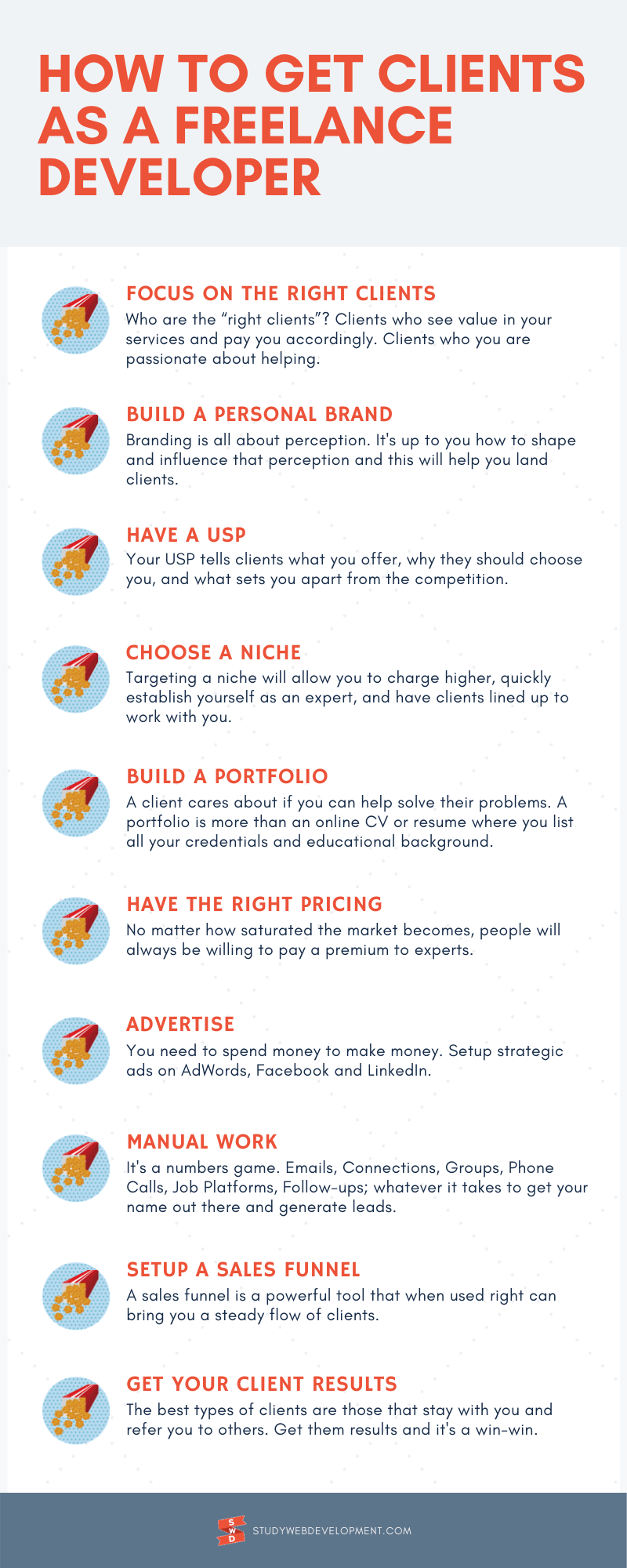
🔥 Bonus Tips
- Avoid directly selling yourself
It may seem counterintuitive, but keep yourself from directly selling your services. Instead of directly saying “I build websites for business coaches,” share a story of how you helped a business coach build a website that ended up closing 5 clients in a month. Most people don't like being sold to and no body likes these sleazy sales calls. Let your results for clients do the "selling" in an indirect way. - Focus on quality over quantity
It may be tempting to churn out blog posts after blog posts or videos after videos just to be able to say that you have lots of content. But people are discerning. Poorly made content can backfire and count against you. Focus on publishing the best pieces on the subject. - Set aside time for learning new skills
Web development and marketing is a constantly evolving field. It’s your job to stay on top of the game. Set aside time to read books, listen to podcasts, watch videos and stay updated on the latest technological advancements so you can sell more services and gain confidence as a developer.
---
Those were the strategies you can start applying today to get clients as a freelance web developer.
Now it’s up to you to apply what you’ve learned to get results. Remember that knowledge leads to nothing without action.
This is the most time and effort we've spent on an article, so if you find it helpful, please share it with others:
Just finished reading How to Get Clients as a Freelance Developer: The Complete Guide
Want Free Bonus Downloads?
- Client Proposal Template
- Sales Follow Up Sheet
- Prospective Client Questionaire
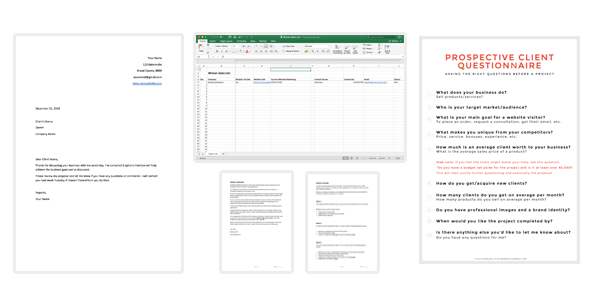
 by Kyle Prinsloo Last updated Aug. 1, 2023
by Kyle Prinsloo Last updated Aug. 1, 2023